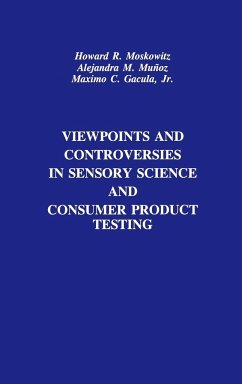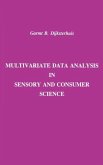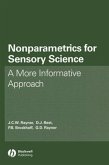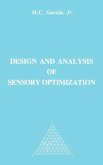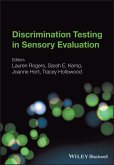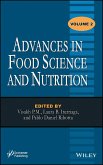Howard R Moskowitz, Alejandra M Muñoz, Maximo C Gacula
Viewpoints and Controversies in Sensory Science and Consumer Product Testing
Howard R Moskowitz, Alejandra M Muñoz, Maximo C Gacula
Viewpoints and Controversies in Sensory Science and Consumer Product Testing
- Gebundenes Buch
- Merkliste
- Auf die Merkliste
- Bewerten Bewerten
- Teilen
- Produkt teilen
- Produkterinnerung
- Produkterinnerung
The authors skillfully present different approaches to the same problem and even different ways to look at the same type of data. If you have ever been stumped by a controversy in product assessment, the design of studies, or the analysis of data, you will find the answer in this book.
Andere Kunden interessierten sich auch für
![Multivariate Data Analysis in Sensory and Consumer Science Multivariate Data Analysis in Sensory and Consumer Science]() Multivariate Data Analysis in Sensory and Consumer Science156,99 €
Multivariate Data Analysis in Sensory and Consumer Science156,99 €![Nonparametrics for Sensory Science Nonparametrics for Sensory Science]() J C W RaynerNonparametrics for Sensory Science248,99 €
J C W RaynerNonparametrics for Sensory Science248,99 €![Design and Analysis of Sensory Optimization Design and Analysis of Sensory Optimization]() Maximo C GaculaDesign and Analysis of Sensory Optimization141,99 €
Maximo C GaculaDesign and Analysis of Sensory Optimization141,99 €![Concept Research in Food Product Design and Development Concept Research in Food Product Design and Development]() Howard R MoskowitzConcept Research in Food Product Design and Development293,99 €
Howard R MoskowitzConcept Research in Food Product Design and Development293,99 €![Discrimination Testing in Sensory Evaluation Discrimination Testing in Sensory Evaluation]() Discrimination Testing in Sensory Evaluation164,99 €
Discrimination Testing in Sensory Evaluation164,99 €![Advances in Food Science and Nutrition, Volume 2 Advances in Food Science and Nutrition, Volume 2]() Advances in Food Science and Nutrition, Volume 2203,99 €
Advances in Food Science and Nutrition, Volume 2203,99 €![Functional Polymers in Food Science Functional Polymers in Food Science]() Functional Polymers in Food Science201,99 €
Functional Polymers in Food Science201,99 €-
-
-
The authors skillfully present different approaches to the same problem and even different ways to look at the same type of data. If you have ever been stumped by a controversy in product assessment, the design of studies, or the analysis of data, you will find the answer in this book.
Produktdetails
- Produktdetails
- Verlag: Wiley
- Seitenzahl: 492
- Erscheinungstermin: 27. Dezember 2004
- Englisch
- Abmessung: 235mm x 157mm x 31mm
- Gewicht: 859g
- ISBN-13: 9780917678578
- ISBN-10: 0917678575
- Artikelnr.: 22347152
- Herstellerkennzeichnung
- Libri GmbH
- Europaallee 1
- 36244 Bad Hersfeld
- gpsr@libri.de
- Verlag: Wiley
- Seitenzahl: 492
- Erscheinungstermin: 27. Dezember 2004
- Englisch
- Abmessung: 235mm x 157mm x 31mm
- Gewicht: 859g
- ISBN-13: 9780917678578
- ISBN-10: 0917678575
- Artikelnr.: 22347152
- Herstellerkennzeichnung
- Libri GmbH
- Europaallee 1
- 36244 Bad Hersfeld
- gpsr@libri.de
Howard R. Moskowitz, Ph. D.,Moskowitz Jacobs, Inc., White Plaines, New York, Alejandra M. Muñoz, M.S., IRIS: International Resources for Insights and Solutions, LLC, Mountainside, New Jersey, and Maximo C. Gacula, Jr., Ph.D., Department of Psychology, Arizona State University, Tempe, Arizona.
1. The Role of Sensory Science in the Coming Decade.
2. International Sensory Science.
3. Sensory Mythology.
4. Contrasting R&D, Sensory Science, and Marketing Research Approaches.
5. Validity and Reliability in Sensory Science.
6. The Interface Between Psychophysics and Sensory Science: Methods vs.
Real Knowledge.
7. Descriptive Panel/Experts vs. Consumers.
8. Sample Issues in Consumer Testing.
9. Hedonics, Just-About-Right, Purchase and Other Scales in Consumer Tests.
10. Asking Consumers to Rate Product Attributes.
11. Questionnaire Design.
12. Choice of Population in Consumer Studies.
13. Biases Due to Changing in Market Conditions.
14. Sample Size N or Number of Respondents.
15. The Use and Caveats of Qualitative Research in the Decision Making
Process.
16. The Four D's of Sensory Science: Difference, Discrimination,
Dissimilarity, Distance.
17. Replication in Sensory and Consumer testing.
18. Language Development in Descriptive Analysis and the Formation of
Sensory Concepts.
19. Use of References in Descriptive Analysis.
20. Training Time in Descriptive Analysis.
21. Consumer-Descriptive Data Relationships in Sensory Science.
22. Product and Panelist Variability in Sensory Testing.
23. Foundations of Sensory Science by Daniel Ennis.
24. Applications of SAS Programming Language in Sensory Analysis by Maximo
Gacula, Jr.
25. Advances and the Future of Data Collection Systems in Sensory Science
by André Arborgast, Chris Findlay and Paul Lichtman.
Index
2. International Sensory Science.
3. Sensory Mythology.
4. Contrasting R&D, Sensory Science, and Marketing Research Approaches.
5. Validity and Reliability in Sensory Science.
6. The Interface Between Psychophysics and Sensory Science: Methods vs.
Real Knowledge.
7. Descriptive Panel/Experts vs. Consumers.
8. Sample Issues in Consumer Testing.
9. Hedonics, Just-About-Right, Purchase and Other Scales in Consumer Tests.
10. Asking Consumers to Rate Product Attributes.
11. Questionnaire Design.
12. Choice of Population in Consumer Studies.
13. Biases Due to Changing in Market Conditions.
14. Sample Size N or Number of Respondents.
15. The Use and Caveats of Qualitative Research in the Decision Making
Process.
16. The Four D's of Sensory Science: Difference, Discrimination,
Dissimilarity, Distance.
17. Replication in Sensory and Consumer testing.
18. Language Development in Descriptive Analysis and the Formation of
Sensory Concepts.
19. Use of References in Descriptive Analysis.
20. Training Time in Descriptive Analysis.
21. Consumer-Descriptive Data Relationships in Sensory Science.
22. Product and Panelist Variability in Sensory Testing.
23. Foundations of Sensory Science by Daniel Ennis.
24. Applications of SAS Programming Language in Sensory Analysis by Maximo
Gacula, Jr.
25. Advances and the Future of Data Collection Systems in Sensory Science
by André Arborgast, Chris Findlay and Paul Lichtman.
Index
1. The Role of Sensory Science in the Coming Decade.
2. International Sensory Science.
3. Sensory Mythology.
4. Contrasting R&D, Sensory Science, and Marketing Research Approaches.
5. Validity and Reliability in Sensory Science.
6. The Interface Between Psychophysics and Sensory Science: Methods vs.
Real Knowledge.
7. Descriptive Panel/Experts vs. Consumers.
8. Sample Issues in Consumer Testing.
9. Hedonics, Just-About-Right, Purchase and Other Scales in Consumer Tests.
10. Asking Consumers to Rate Product Attributes.
11. Questionnaire Design.
12. Choice of Population in Consumer Studies.
13. Biases Due to Changing in Market Conditions.
14. Sample Size N or Number of Respondents.
15. The Use and Caveats of Qualitative Research in the Decision Making
Process.
16. The Four D's of Sensory Science: Difference, Discrimination,
Dissimilarity, Distance.
17. Replication in Sensory and Consumer testing.
18. Language Development in Descriptive Analysis and the Formation of
Sensory Concepts.
19. Use of References in Descriptive Analysis.
20. Training Time in Descriptive Analysis.
21. Consumer-Descriptive Data Relationships in Sensory Science.
22. Product and Panelist Variability in Sensory Testing.
23. Foundations of Sensory Science by Daniel Ennis.
24. Applications of SAS Programming Language in Sensory Analysis by Maximo
Gacula, Jr.
25. Advances and the Future of Data Collection Systems in Sensory Science
by André Arborgast, Chris Findlay and Paul Lichtman.
Index
2. International Sensory Science.
3. Sensory Mythology.
4. Contrasting R&D, Sensory Science, and Marketing Research Approaches.
5. Validity and Reliability in Sensory Science.
6. The Interface Between Psychophysics and Sensory Science: Methods vs.
Real Knowledge.
7. Descriptive Panel/Experts vs. Consumers.
8. Sample Issues in Consumer Testing.
9. Hedonics, Just-About-Right, Purchase and Other Scales in Consumer Tests.
10. Asking Consumers to Rate Product Attributes.
11. Questionnaire Design.
12. Choice of Population in Consumer Studies.
13. Biases Due to Changing in Market Conditions.
14. Sample Size N or Number of Respondents.
15. The Use and Caveats of Qualitative Research in the Decision Making
Process.
16. The Four D's of Sensory Science: Difference, Discrimination,
Dissimilarity, Distance.
17. Replication in Sensory and Consumer testing.
18. Language Development in Descriptive Analysis and the Formation of
Sensory Concepts.
19. Use of References in Descriptive Analysis.
20. Training Time in Descriptive Analysis.
21. Consumer-Descriptive Data Relationships in Sensory Science.
22. Product and Panelist Variability in Sensory Testing.
23. Foundations of Sensory Science by Daniel Ennis.
24. Applications of SAS Programming Language in Sensory Analysis by Maximo
Gacula, Jr.
25. Advances and the Future of Data Collection Systems in Sensory Science
by André Arborgast, Chris Findlay and Paul Lichtman.
Index

